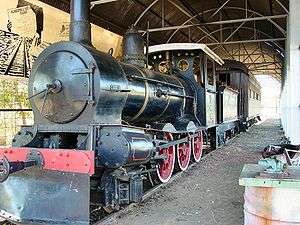South Australian Railways W class
|
NF5 (formerly W53) preserved at Pine Creek, Northern Territory | |||||||||||||||||||||||||
| |||||||||||||||||||||||||
| |||||||||||||||||||||||||
| |||||||||||||||||||||||||
| |||||||||||||||||||||||||
The South Australian Railways W/Wx class was a class of 2-6-0 steam locomotives operated by the South Australian Railways and later the Commonwealth Railways.
History
The W class were ordered as light goods locomotives for use on the expanding South Australian Railways (SAR) 3 ft 6 in (1,067 mm) gauge networks, limited in size and weight by the requirement they must be able to run on 40 lb/yd rails as were in use at the time.[1] The locomotives were built by Beyer, Peacock & Co of Manchester as a variation on the narrow gauge Mogul design widely used in Australia at the time.
Early W class units were used during construction of the Central Australia Railway between Port Augusta and Quorn in 1878 prior to entering revenue service with SAR. During their operational career, the locomotives were used within South Australia on the isolated Eyre Peninsular Railway, in the south east on now closed lines in the Kingston, Naracoorte and Mount Gambier areas as well as the line north from Port Augusta. Many were sold or leased to contractors and they were also used by the Railways Construction Branch.[2] Several of the locomotives were sold to C&E Millar and used for construction of the Palmerston and Pine Creek Railway in the Northern Territory and would continue to work the isolated line for the remainder of their operational lives.[3]
Wx and NF classes
From 1903, the SAR began to rebuild W class locomotives with upgraded boilers. This allowed for an increase in boiler pressure to 145 psi (1,000 kPa), improving the tractive effort to 8,566 lbf (38.10 kN).[1] 18 of the class were rebuilt and designated Wx class.
In 1911, South Australia handed administrative responsibility for the Northern Territory, including the Palmerston and Pine Creek Railway to the Commonwealth. Five unmodified W class locomotives were transferred to Commonwealth Railways at the Parap Railway Workshops and designated NF class. The condition of these locomotives was such that W35 and W41 were stripped down, and the parts from both used to make NF7, an operational locomotive. Commonwealth Railways purchased an additional two locomotives of the class in 1915 from private interests involved with the Eyre Peninsular Railway.[4]
Withdrawal from service
By 1929, unmodified W class units had been withdrawn from service by South Australian Railways with the majority sold for scrap. TW22 had been sold to Western Australian Government Railways in 1893 and was not withdrawn until 1958, and W38, in private hands with Baxter and Saddler from 1896 and was finally condemned in 1955. A number of modified Wx class units were also withdrawn in 1929, however a small number endured until 1959[3] when the south eastern narrow gauge lines were converted to 5 ft 3 in (1,600 mm) broad gauge.
The six units converted by Commonwealth Railways to NF class were withdrawn between 1928 and 1945, with three of the class operating the line during World War II. NF6 was destroyed during the first Japanese air raid on Darwin in 1942[4] while shunting munitions on the Stokes Hill jetty. The locomotive was blown into the harbour and while both driver and fireman survived, the fate of NF6 remains unknown as it has never been officially salvaged or located.[5]
Preservation
Two have been preserved:
- NF5 (W53) has been restored to operational condition at Pine Creek, Northern Territory. One of the earliest examples of the class, W53 was built in 1877 and was used on the construction of the Port Augusta - Quorn and was one of two W class purchased by Commonwealth Railways in 1915 and redesignated NF5 for use on the North Australia Railway. NF5 was withdrawn from service following the end of World War II and was preserved and displayed in several locations around Darwin,[4] before its eventual relocation to Pine Creek, where it was restored to operating condition as a Centenary of Federation project by the Pine Creek Community Government Council.[6]
- Wx18 is stored at the Pichi Richi Railway, Quorn. This locomotive entered service in July 1879 and was upgraded to Wx class in 1911. On 12 March 1959, Wx18 hauled the last narrow gauge goods train on the Kingston - Naracoorte line where it had spent its operational life. It was preserved in Pioneer Park in Naracoorte until being moved to Pichi Richi in July 1985. It is currently in a disassembled condition awaiting restoration.[3]
References
- 1 2 Llanso, Steve. "South Australian Railways 2-6-0 Locomotives". SteamLocomotive.com. Archived from the original on May 29, 2012.
- ↑ Webshots Archived October 28, 2012, at the Wayback Machine.
- 1 2 3 Drymalik, Chris. "Locomotive Information: Narrow Gauge W/Wx-class 2-6-0 locomotives". ComRails.
- 1 2 3 Drymalik, Chris. "Locomotive Information: Narrow Gauge NF". ComRails.
- ↑ "The Ex-SAR W or CR class NF in Darwin Habour [sic]". RailPage. January 8, 2012.
- ↑ "Pine Creek". Katherine: Adventure Territory. Katherine Visitor Information Centre.
External links
![]() Media related to South Australian Railways W class at Wikimedia Commons
Media related to South Australian Railways W class at Wikimedia Commons
